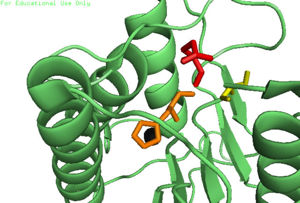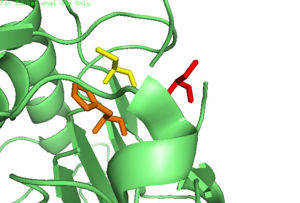User:Luke Edward Severinac/Sandbox 1
From Proteopedia
(Difference between revisions)
| Line 17: | Line 17: | ||
=='''Zinc Inhibition'''== | =='''Zinc Inhibition'''== | ||
Caspase-6 can also assume an inactive state, which exists as a <scene name='75/752344/Casp_6_inactive_dimer/1'>dimer</scene> in its biological unit. For each <scene name='75/752344/Casp_6_inactive_monomer/1'>monomer</scene>, Caspase-6 function is primarily inhibited by the binding of a <scene name='75/752344/Casp_6_inactive_monomer_zinc/1'>zinc</scene> ion, which binds to an <scene name='75/752344/Casp_6_alosteric_site/1'>allosteric site</scene> instead of the <scene name='75/752344/Casp_6_alostericactive_site/1'>active site</scene>. This allosteric site is located on the opposite side of the protein relative to the active site. The zinc ion is bound to <scene name='75/752344/Caspase6_alloster_resid/1'>three residues</scene>, Lys-36, Glu-244, and His-287. Once the ion is bound to the protein, it is then stabilized by a <scene name='75/752344/Caspase6_alloster_h20/1'>water molecule</scene> found in the cytoplasm. The binding of zinc at the exosite is suggested to cause a conformational change in the protein from an <scene name='75/752344/Catalytic_triad_real_monomer/1'>active state</scene> to an <scene name='75/752344/Casp_6_inactive_cat_triad/1'>inactive state</scene> that misaligns catalytic residues and inhibits activity of the enzyme. It has been proposed that helices of the active dimer must rotate or move in some other way to provide these ideal interactions with zinc. This subtle shift is most likely the cause for allosteric inhibition. As the helices move to bind zinc, the amino acids of the active site become misaligned. The altered positions of the amino acids no longer provide ideal interactions for incoming substrates. After zinc binds, substrates may still enter the active site, but no catalytic activity will occur. | Caspase-6 can also assume an inactive state, which exists as a <scene name='75/752344/Casp_6_inactive_dimer/1'>dimer</scene> in its biological unit. For each <scene name='75/752344/Casp_6_inactive_monomer/1'>monomer</scene>, Caspase-6 function is primarily inhibited by the binding of a <scene name='75/752344/Casp_6_inactive_monomer_zinc/1'>zinc</scene> ion, which binds to an <scene name='75/752344/Casp_6_alosteric_site/1'>allosteric site</scene> instead of the <scene name='75/752344/Casp_6_alostericactive_site/1'>active site</scene>. This allosteric site is located on the opposite side of the protein relative to the active site. The zinc ion is bound to <scene name='75/752344/Caspase6_alloster_resid/1'>three residues</scene>, Lys-36, Glu-244, and His-287. Once the ion is bound to the protein, it is then stabilized by a <scene name='75/752344/Caspase6_alloster_h20/1'>water molecule</scene> found in the cytoplasm. The binding of zinc at the exosite is suggested to cause a conformational change in the protein from an <scene name='75/752344/Catalytic_triad_real_monomer/1'>active state</scene> to an <scene name='75/752344/Casp_6_inactive_cat_triad/1'>inactive state</scene> that misaligns catalytic residues and inhibits activity of the enzyme. It has been proposed that helices of the active dimer must rotate or move in some other way to provide these ideal interactions with zinc. This subtle shift is most likely the cause for allosteric inhibition. As the helices move to bind zinc, the amino acids of the active site become misaligned. The altered positions of the amino acids no longer provide ideal interactions for incoming substrates. After zinc binds, substrates may still enter the active site, but no catalytic activity will occur. | ||
| + | |||
| + | [[Image:4FXO-FINAL.jpg|300px|Caspase-6 w/ Zinc Bound]] [[Image:3s70.jpg|300px|Caspase-6 w/o Zinc Bound]] | ||
| + | |||
=='''Phosphorylation'''== | =='''Phosphorylation'''== | ||
The function of Caspase-6 can be inhibited by phosphorylation of Ser-257. The exact mechanism of this reaction remains unidentified at the time of publication, but proceeds when ARK5 kinase is present. This modification can occur before and after zymogen activation. The phosphoryl group inhibits Caspase-6 through steric interference. When Ser-257 is phosphorylated, the amino acid residue interacts with <scene name='75/752344/Caspase-6_his-208/1'>Pro-201</scene>, causing a shift in the helices of Caspase-6. This is shown in the <scene name='75/752344/Caspase-6_s257d_mutant/1'>S257D Caspase-6 mutant</scene>, whose mutation mimics phosphorylation. <ref name="Phosregcasp6subsbindgroove">PMID: 22483120 </ref> The shift misaligns and disrupts residues found in the active site. This conformational difference prevents the intersubunit linker from entering during zymogen activation and the self-cleaved active dimer cannot be formed. Additionally, no new substrate is able to enter the active site. | The function of Caspase-6 can be inhibited by phosphorylation of Ser-257. The exact mechanism of this reaction remains unidentified at the time of publication, but proceeds when ARK5 kinase is present. This modification can occur before and after zymogen activation. The phosphoryl group inhibits Caspase-6 through steric interference. When Ser-257 is phosphorylated, the amino acid residue interacts with <scene name='75/752344/Caspase-6_his-208/1'>Pro-201</scene>, causing a shift in the helices of Caspase-6. This is shown in the <scene name='75/752344/Caspase-6_s257d_mutant/1'>S257D Caspase-6 mutant</scene>, whose mutation mimics phosphorylation. <ref name="Phosregcasp6subsbindgroove">PMID: 22483120 </ref> The shift misaligns and disrupts residues found in the active site. This conformational difference prevents the intersubunit linker from entering during zymogen activation and the self-cleaved active dimer cannot be formed. Additionally, no new substrate is able to enter the active site. | ||
Revision as of 13:56, 21 April 2017
Caspase-6 in Homo sapiens
| |||||||||||




